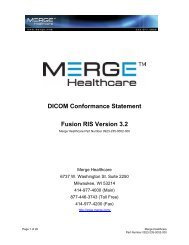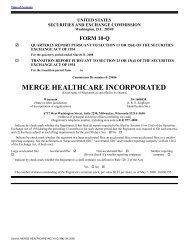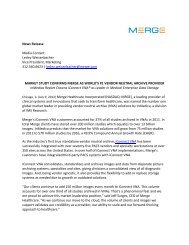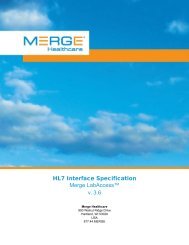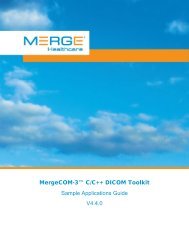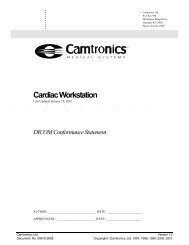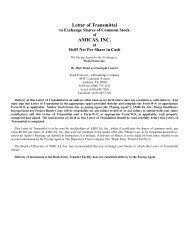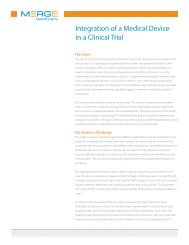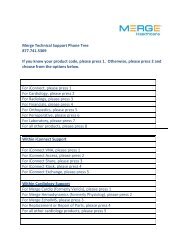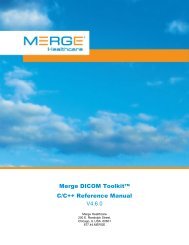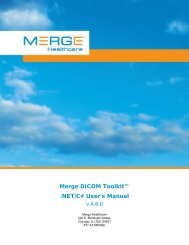DICOM Conformance Statement for Cedara I ... - Merge Healthcare
DICOM Conformance Statement for Cedara I ... - Merge Healthcare
DICOM Conformance Statement for Cedara I ... - Merge Healthcare
You also want an ePaper? Increase the reach of your titles
YUMPU automatically turns print PDFs into web optimized ePapers that Google loves.
(2004-02987) <strong>DICOM</strong> <strong>Con<strong>for</strong>mance</strong> <strong>Statement</strong> <strong>for</strong> <strong>Cedara</strong> I-SoftView 6.3<br />
The dcserver is expected to be running on the local workstation. A Remote Application Entity<br />
initiates an association <strong>for</strong> Storage Services. Upon notification of acceptance of the association<br />
parameters, the Remote Application Entity sends In<strong>for</strong>mation Objects to the dcserver that stores<br />
them in a local database <strong>for</strong> future use by the workstation.<br />
The user initiates Query and Retrieve requests using the dcserver component, generally by<br />
interaction with a User Interface. The dcserver component initiates an association with the<br />
Remote Application Entity and uses the Query or Retrieve Service Classes to issue commands.<br />
The Remote Application Entity responds as a Query/Retrieve Service Class Provider per<strong>for</strong>ming<br />
C-FIND and C-MOVE operations as required. The dcserver component passes the status<br />
responses <strong>for</strong> these commands to the workstation User Interface <strong>for</strong> interpretation and display.<br />
The hcserver can be running on the local or a remote workstation. The application using the<br />
hcserver requests printing to a print device. The hcserver initiates an association with a <strong>DICOM</strong><br />
print SCP <strong>for</strong> the purpose of printing the job requested by the application. The hcserver can<br />
handle simultaneous associations with a number of <strong>DICOM</strong> print SCPs.<br />
2.2 Functional Definitions of Application Entities<br />
The dcserver component operates as a daemon. The start-up sequence of the system initiates its<br />
execution. The dcserver is left running whether the workstation is operational or not.<br />
The dcserver uses a configuration file that contains in<strong>for</strong>mation used to validate association<br />
attempts from Remote Application entities. The dcserver then listens on the configured port <strong>for</strong><br />
association requests.<br />
An association request <strong>for</strong> Storage Services from a Remote Application Entity causes dcserver to<br />
validate the request according to the configuration parameters set at execution time. The Remote<br />
Application Entity then sends the In<strong>for</strong>mation Object Instance. The dcserver stores the received<br />
In<strong>for</strong>mation Object Instance in its local database if the data does not already exist. The data<br />
remains in the database until removed by some action external to this Application Entity.<br />
An association request from a Remote Application Entity <strong>for</strong> Query or Move Services causes<br />
dcserver to validate the request according to the configuration parameters set at execution time.<br />
The Remote Application Entity then sends the Query or Retrieve request. The dcserver searches<br />
the local database <strong>for</strong> the instance(s) specified. If the request was C_FIND, then a response is<br />
returned <strong>for</strong> each match. If the request was C_MOVE, then an association is originated to the<br />
destination Application Entity specified in the C_MOVE message. Incremental responses are<br />
sent to the C_MOVE originator to indicate progress of the request.<br />
A request from the workstation User Interface causes the dcserver component to initiate an<br />
association with a Remote Application Entity. The Service Classes offered are specified in the<br />
configuration file. The user can then initiate query and retrieve requests to dcserver that are sent<br />
to the Remote Application Entity. The workstation User Interface displays the responses from<br />
the Remote Application Entity.<br />
The hcserver component operates as a daemon. The start-up sequence of the system initiates its<br />
execution. The hcserver is left running whether the workstation is operational or not.<br />
<strong>Merge</strong> OEM Page 9 of 39




